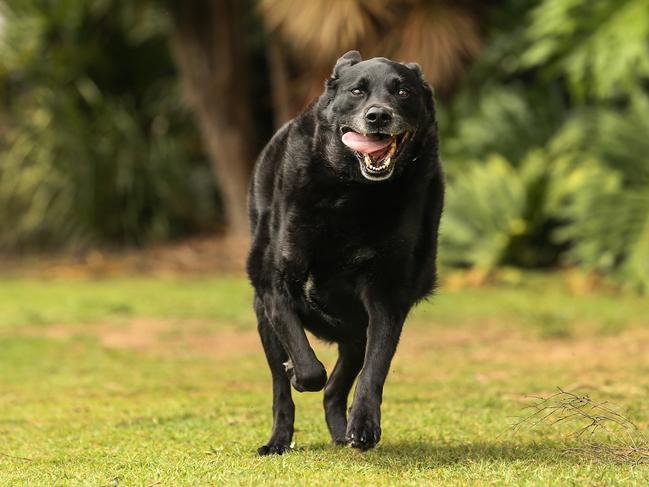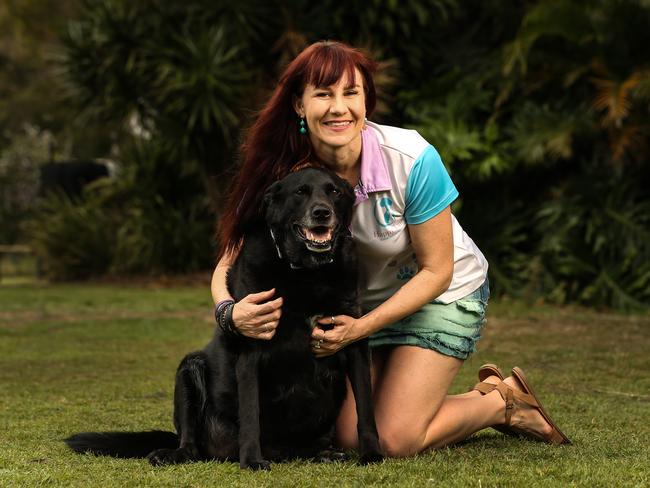‘He was so depressed’: 75kg dog given new lease on life with new diet
Severely obese and abandoned by his owners, 75kg labrador Morris was moments from being put down until foster carers saved his life. See what he looks like now.
Pets and Wildlife
Don't miss out on the headlines from Pets and Wildlife. Followed categories will be added to My News.
Severely obese, eleven-year-old black Labrador, Morris, was abandoned by his owners and left to be euthanised, before foster carers saved his life.
At 75kg, Morris’ previous owners gave him up to a shelter where he was moments away from being put down due to his weight, when the Happy Tails rescue team stepped in.
Foster carer Stacey Robertson-Falvey said when Morris came to her, he couldn’t walk more than five to 10 metres without becoming exhausted and needing to sit down.
“He couldn’t run around with other dogs, he would want to play but he couldn’t get up, he was always out of breath,” she said.

After just over a year of strict dieting on prescribed weight loss food and easing into light exercise, Morris has now shed 25kg and has a new lease on life.
“Honestly he’s a different dog, when I got him he was so depressed. He would just lie down and watch other dogs run around,” she said.
“Now he’s getting the toys out of the bucket and bringing them to you to play with. He’s getting his puppy spirit back in him at his old age.”
With the help of treatments like hydrotherapy, Ms Robertson-Falvey said he’s on the right track, but he still has a long road to go to become his healthiest self.
“He’s still got a lot of weight to lose, he’s still a big boy. He probably needs to be 35kg to 40kg and he’d be feeling pretty healthy,” she said.
Sherwood Vet Practice nurse Caitlyn Verbeek said weight gain on pets could sometimes be less obvious to owners than to the professionals, especially for fluffier dogs and cats.
“Diet and exercise are the biggest thing. From when you get a puppy having them on a good quality food and following the instructions on the packet to a tee is vital,” she said.
“Then having a good exercise regimen of 30 minutes a day is phenomenal.”

At least 41 per cent of dogs and 31 per cent of cats in Australia are currently overweight or obese, putting them at serious risk of disease or early death, according to the Australian Veterinary Association.
Royal Canin veterinarian Dr Corey Regnerus said obesity issues mostly stem from pet owners’ distorted view on what a healthy animal looks like and how much to feed them.
He said most owners were unaware that one kilogram for a cat feels like 16kg for a human, and a dog losing one kilogram would equate to a human losing 7kg.
“What we see as normal, is not healthy,” Dr Regnerus said.
“Part of that is when we look at social media and see what pets are around, we tend to like chubby, cute pets.
“Research has shown that for obese dogs, especially small dogs, being overweight can reduce their lifespan by up to 2.5 years, which equals 17 years in human life and cats are quite the same, with a 1.5-2 years reduced lifespan.
“Those (deaths) tend to be due to secondary implications like diabetes, skin disease, jaundice, the usual side effects of obesity.”

Royal Canin recently surveyed 8,000 Australian and New Zealand pet owners to gauge their feeding habits and general understanding of pet obesity.
The research found one in three did not know how to check if their pet was at a healthy weight and while a further 42 per cent said they would tackle weight issues by reducing their pet’s food, they showed a lack of understanding on how to safely manage their pet’s weight.
“And 54 per cent said they will sometimes or always treat their pet when they beg, so understanding that when your pet is begging, it could be for attention and not for another meal,” Dr Regnerus said.
“If we could stop doing that, we’re on the track for weight loss.”
Australia is not the only country affected by poor pet health, with global obesity rates soaring up to 70 per cent.
Dr Regnerus said the best way for owners to check their pet’s weight is to conduct a body score test, or simply seek proper advice from their vet.
“Each weight loss training is unique to the individual pet and just like us it's important to initiate a healthy weight loss journey,” he said.
“Similar to humans, we don't want them to lose weight too quickly and we want it to be sustainable so they don’t rebound.
“Body condition score is a great place to start, you want to be able to easily feel the ribs on their sides, feel a nice little tummy tuck from the stomach to the back legs and look for a visible hourglass waist from the top.
“Vets can guide you on how to do this as well and if you find your pet is overweight or obese, go straight to your vet.”




